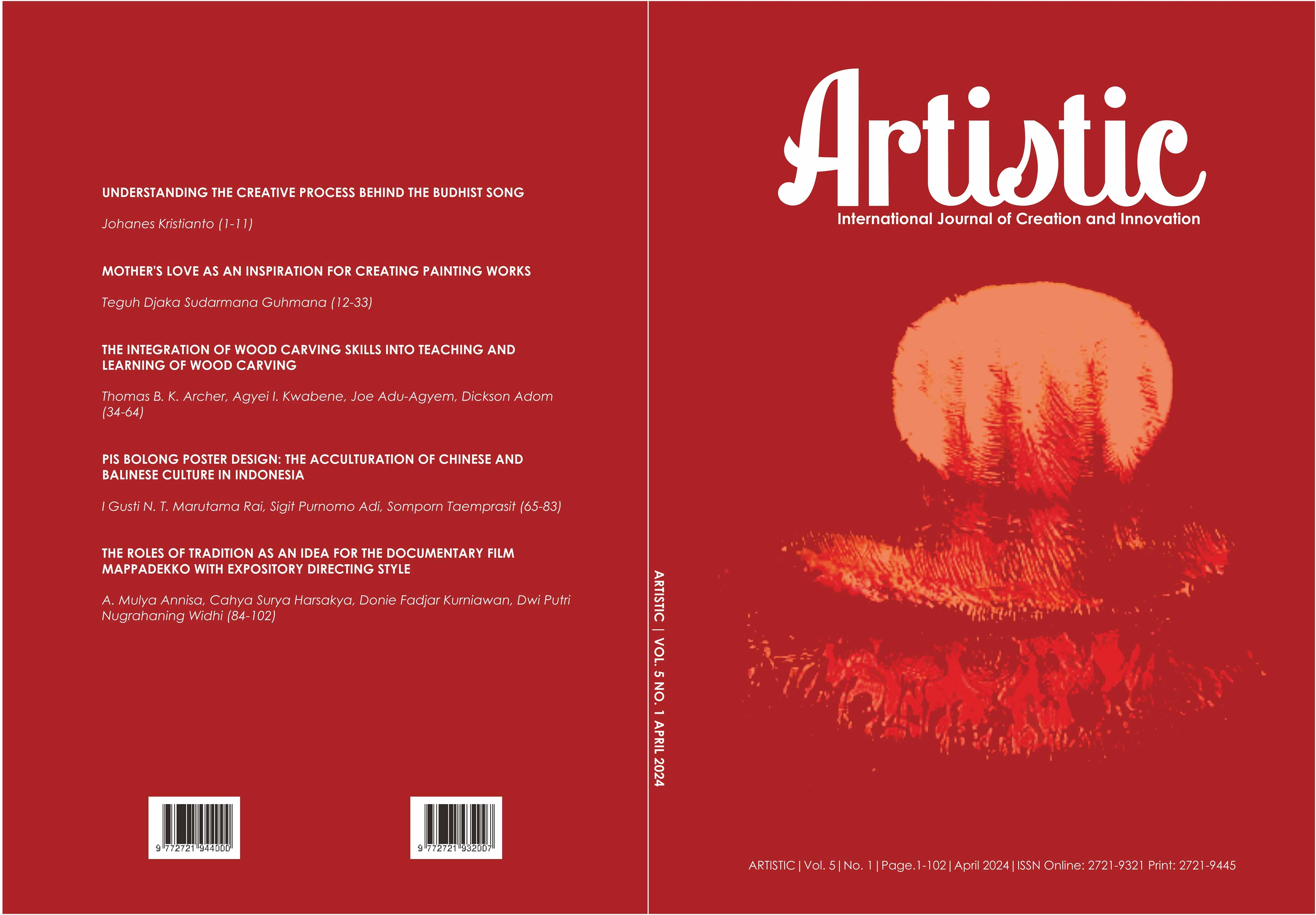THE INTEGRATION OF WOOD CARVING SKILLS INTO TEACHING AND LEARNING OF WOOD CARVING
DOI:
https://doi.org/10.33153/artistic.v5i1.6279Keywords:
wood, carving, creativity, tools, finishingAbstract
Wood carving has been an integral part of many ethnic groups in Ghana and worldwide. Currently, Ghanaian wood carvers produce countless varieties of wooden sculptures for tourist trade or export. The wood carving business in Vakpo has provided employment for natives in the production of different wooden objects such as stools, umbrella tops, linguist staffs, walking sticks, human and animal figures/figurines, and many more. Unlike any other wood carving industry, one of the major challenges facing Vakpo traditional wood carving is less recognition by art lovers due to scanty literature in the town and insufficient art enthusiasts in Ghana. The study adopts a qualitative research design with a descriptive research method. The data was gathered through observations and interviews. The results indicate that wood carvers in Vakpo exhibit mastery in creativity, intricate cuts as well as finishing, and their quality wood carvings are by no means inferior to the wooden sculptures of other wood carvers from renowned towns such as Aburi, Ahwiaa, Foase, and others.
Downloads
References
Adu-Agyem, J. … Mensah, E. (2014). Wood carving in the Akuapem Hills of Ghana: Prospects, challenges and the way forward. International Journal of Business and Management Review, 2(1), 148 – 177.
Amoh, E. (2009). Ahwiaa wood carving industry: New trends and their implication for Art education. KNUST.
Boakye-Yiadom, F. … Donkor, E. K. (2022). Pseudo traditional wood sculptures in TTU, Ghana: A study of Four works by an Artist-Lecturer. Journal of Arts and Humanities, 11(2), 24 – 35. https://doi.org/10.18533/journal.v9i1.1809
Choge, S. K. (2000). Study of economic aspects of the wood carving industry in Kenya: Implications for policy development to make the industry more sustainable. University of Natal.
Coleman, A. (2016). Preservation of indigenous wood carving knowledge of African traditional people through the use of traditional wood carvers database framework. Indian Journal of Traditional Knowledge, 15(3), 370 – 377.
Haron, H. … Narimah, A. M. (2014). Cut out carving: an innovation of Malay Heritage Design Pattern (Labu Sayong). Middle-East Journal of Scientific Research, 21(6), 936 – 944. https://doi.org/10.5829/idosi.mejsr.2014.21.06.21212
Ismail, N. H. … Manan, S. A. (2014). The meaning of Malay Motif woodcarving in Terengganu Mosque. Malaycivilization. http://www.malaycivilization.com.my/items/show/137732
Laurent, M. N. (2009). Small and Medium Enterprises (SMEs) and Sustainable Development: The Case of Makonde Wood Carvers in Mwenge, Dar-es- Salaam Tanzania. The University of Agder.
Maingi, B. … Kibet, N. (2017). Woodcarving and its socio-economic implications on Household livelihoods in Wamunyu location, Yathui Sub-county, Machakos County, Kenya. International Journal of Development Research, 7(2), 11686 – 11692.
Muga, M. O. … Chikamai, B. N. (2014). Classification of Kenyan Wood carving species using Macroscopic and Microscopic properties. International Journal of Applied Science and Technology, 4(3), 167 – 178.
Muthini, S. M. (2017). Small Scale wood carving enterprises and their contribution to rural livelihoods in Wamunyu, Machakos County, Kenya. Kenyatta University.
Nazuki, S. N., & Kamarudin, Z. (2017). Techniques of wood carving applied in the architectural elements of Malay Vernacular Buildings. Journal of Building Environment, Technology and Engineering, 2, 198 – 202.
Offei, H. E. (2002). Sculpture Theory and Practice for Senior High Schools and Colleges. Agya Wusu Press.
Okrah, E. (2002). he Growth of woodcarving Industry in Ghana and its threat to selected tree species. Lund University.
Oladimeji, Y. U. (2013). Potentials and the Socio-Economic Benefits of Blacksmithing Production in Promoting Agricultural Development and Poverty Alleviation in Kwara State, Nigeria. International Journal of Modern Engineering Research, 3(6), 3809–3817.
Radkau, J. (2011). Wood: A History. Polity Press.
Saputri, P., & Yuwono, B. T. (2022). The Creation of Raden Adjeng Kartini’s Putut Dhapur Keris. ARTISTIC : International Journal of Creation and Innovation, 3(1), 89–114. https://doi.org/10.33153/artistic.v3i1.4454
Sunderland, T., & Ndoye, O. (2004). Forest Products, Livelihoods and Conservation: Case studies of Non-timber forest products system. Center of International Forestry Research.
Ullah, I. (2018). Woodcarving – traditional art of Malaysia to be a safeguard and protected. Ideology Journal of Arts and Social Science, 3(1), 87 – 94. https://doi.org/https://doi.org/10.24191/idealogy.v3i1.45
Downloads
Published
How to Cite
Issue
Section
License
Copyright (c) 2024 Agyei Isaac Kwabene

This work is licensed under a Creative Commons Attribution-NonCommercial-ShareAlike 4.0 International License.
Copyright
Authors who publish with Artistic agree to the following terms:
- Authors retain copyright and grant the journal right of first publication with the work simultaneously licensed under a Creative Commons Attribution License (CC BY-SA 4.0) that allows others to share the work with an acknowledgment of the work's authorship and initial publication in this journal.
- Authors are able to enter into separate, additional contractual arrangements for the non-exclusive distribution of the journal's published version of the work (e.g., post it to an institutional repository or publish it in a book), with an acknowledgment of its initial publication in this journal.
This work is licensed under a Creative Commons Attribution-ShareAlike 4.0


